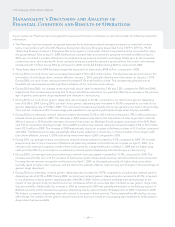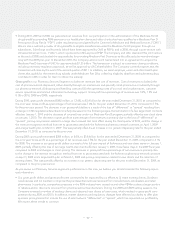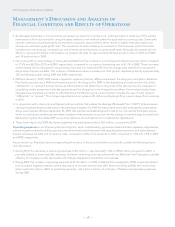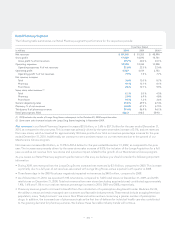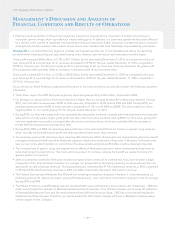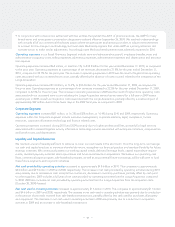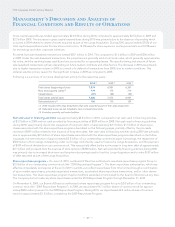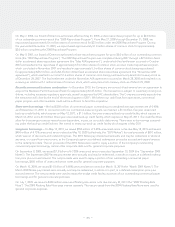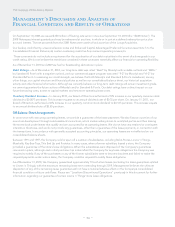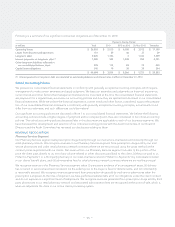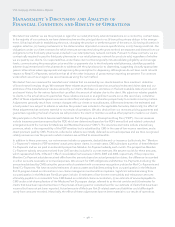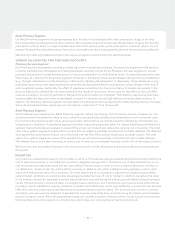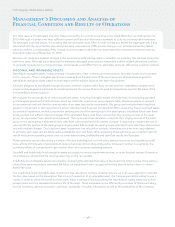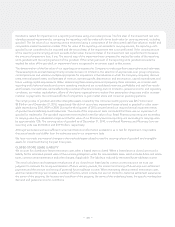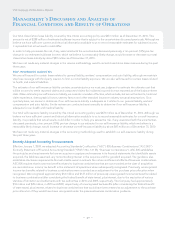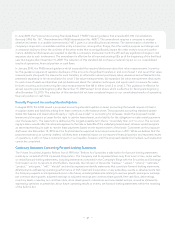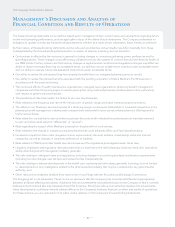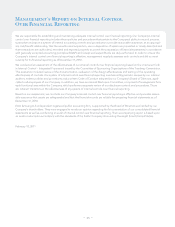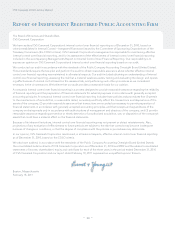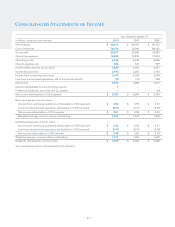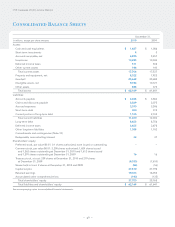CVS 2010 Annual Report Download - page 40
Download and view the complete annual report
Please find page 40 of the 2010 CVS annual report below. You can navigate through the pages in the report by either clicking on the pages listed below, or by using the keyword search tool below to find specific information within the annual report.
Management’s Discussion and Analysis of
Financial Condition and Results of Operations
We determine whether we are the principal or agent for our retail pharmacy network transactions on a contract by contract basis.
In the majority of our contracts, we have determined we are the principal due to us: (i) being the primary obligor in the arrange-
ment, (ii) having latitude in establishing the price, changing the product or performing part of the service, (iii) having discretion in
supplier selection, (iv) having involvement in the determination of product or service specifications, and (v) having credit risk. Our
obligations under our client contracts for which revenues are reported using the gross method are separate and distinct from our
obligations to the third party pharmacies included in our retail pharmacy network contracts. Pursuant to these contracts, we are
contractually required to pay the third party pharmacies in our retail pharmacy network for products sold, regardless of whether
we are paid by our clients. Our responsibilities under these client contracts typically include validating eligibility and coverage
levels, communicating the prescription price and the co-payments due to the third party retail pharmacy, identifying possible
adverse drug interactions for the pharmacist to address with the physician prior to dispensing, suggesting clinically appropriate
generic alternatives where appropriate and approving the prescription for dispensing. Although we do not have credit risk with
respect to Retail Co-Payments, we believe that all of the other indicators of gross revenue reporting are present. For contracts
under which we act as an agent, we record revenues using the net method.
We deduct from our revenues the manufacturers’ rebates that are earned by our clients based on their members’ utilization
of brand-name formulary drugs. We estimate these rebates at period-end based on actual and estimated claims data and our
estimates of the manufacturers’ rebates earned by our clients. We base our estimates on the best available data at period-end
and recent history for the various factors that can affect the amount of rebates due to the client. We adjust our rebates payable
to clients to the actual amounts paid when these rebates are paid or as significant events occur. We record any cumulative
effect of these adjustments against revenues as identified, and adjust our estimates prospectively to consider recurring matters.
Adjustments generally result from contract changes with our clients or manufacturers, differences between the estimated and
actual product mix subject to rebates or whether the product was included in the applicable formulary. Historically, the effect of
these adjustments has not been material to our results of operations. We also deduct from our revenues pricing guarantees and
guarantees regarding the level of service we will provide to the client or member as well as other payments made to our clients.
We participate in the Federal Government’s Medicare Part D program as a Prescription Drug Plan (“PDP”). Our net revenues
include insurance premiums earned by the PDP, which are determined based on the PDP’s annual bid and related contractual
arrangements with the Centers for Medicare and Medicaid Services (“CMS”). The insurance premiums include a beneficiary
premium, which is the responsibility of the PDP member, but is subsidized by CMS in the case of low-income members, and a
direct premium paid by CMS. Premiums collected in advance are initially deferred as accrued expenses and are then recognized
ratably as revenue over the period in which members are entitled to receive benefits.
In addition to these premiums, our net revenues include co-payments, deductibles and co-insurance (collectively, the “Member
Co-Payments”) related to PDP members’ actual prescription claims. In certain cases, CMS subsidizes a portion of these Member
Co-Payments and we are paid an estimated prospective Member Co-Payment subsidy, each month. The prospective Member
Co-Payment subsidy amounts received from CMS are also included in our net revenues. We assume no risk for these amounts,
which represented 2.6%, 3.5% and 1.3% of consolidated net revenues in 2010, 2009 and 2008, respectively. If the prospective
Member Co-Payment subsidies received differ from the amounts based on actual prescription claims, the difference is recorded
in either accounts receivable or accrued expenses. We account for CMS obligations and Member Co-Payments (including the
amounts subsidized by CMS) using the gross method consistent with our revenue recognition policies for Mail Co-Payments and
Retail Co-Payments. We have recorded estimates of various assets and liabilities arising from our participation in the Medicare
Part D program based on information in our claims management and enrollment systems. Significant estimates arising from
our participation in the Medicare Part D program include: (i) estimates of low-income cost subsidy and reinsurance amounts
ultimately payable to or receivable from CMS based on a detailed claims reconciliation, (ii) an estimate of amounts payable to
CMS under a risk-sharing feature of the Medicare Part D program design, referred to as the risk corridor and (iii) estimates for
claims that have been reported and are in the process of being paid or contested and for our estimate of claims that have been
incurred but have not yet been reported. Actual amounts of Medicare Part D-related assets and liabilities could differ signifi-
cantly from amounts recorded. Historically, the effect of these adjustments has not been material to our results of operations.
– 36 –
CVS Caremark 2010 Annual Report


